If you are in search of garden flowers that produce truly spectacular blooms in a variety of bright colors, it is hard to go wrong with dahlias.
You may have a lot of questions about growing dahlias in your flower garden, however.
How do you plant them? How do you take care of them? When do they bloom? How long do they last?
In this growing guide for dahlias, we will answer all of these questions add more. Let’s get started.
Jump to:
- What Are Dahlias?
- Dahlia Basics
- Why Grow Dahlias?
- Recommended Dahlia Flower Varieties
- Where Do Dahlias Grow?
- When Do Dahlias Bloom?
- How Long Do Dahlias Bloom?
- When to Plant Dahlias
- How to Plant Dahlias
- How to Transplant Dahlias
- Ideal Growing Conditions for Dahlias
- How to Care for Dahlias
- How to Prune Dahlias
- What to Know About Dahlia Tubers
- Recommended Companion Plants for Dahlias
- Where to Buy Dahlias
- Frequently Asked Questions About Growing Dahlias
What Are Dahlias?
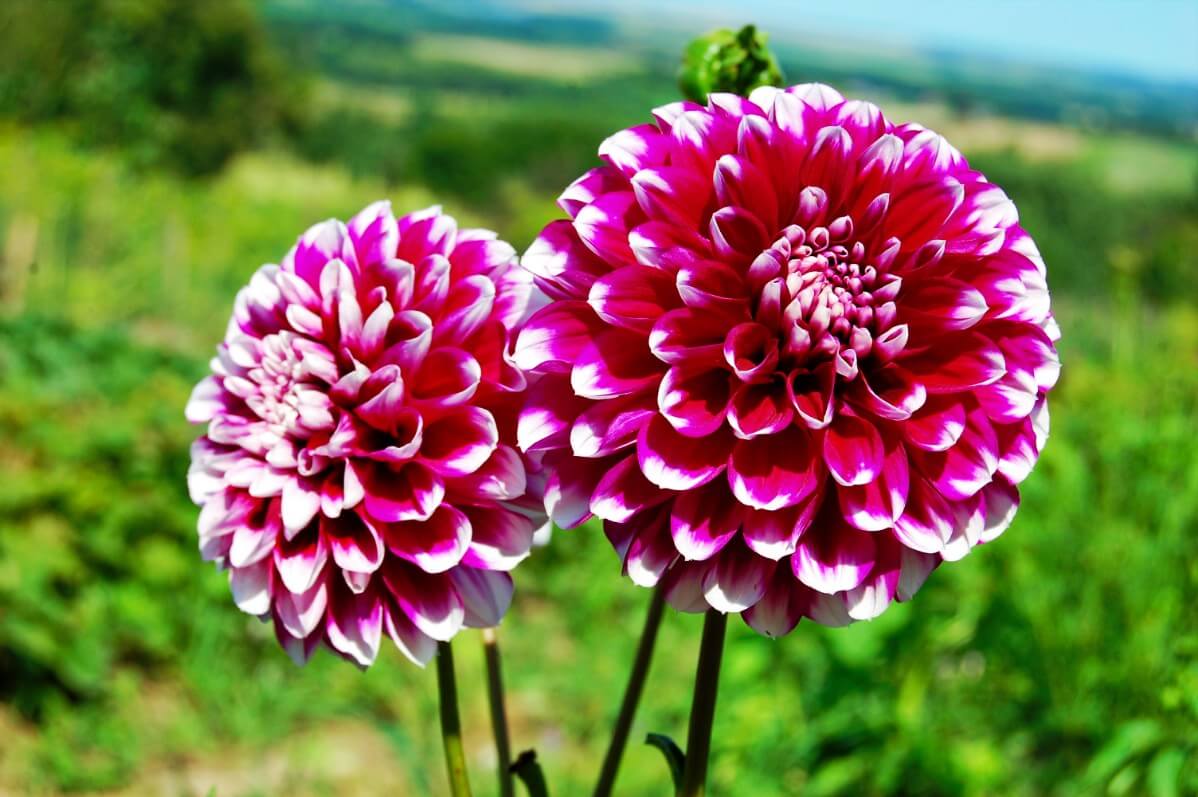
Dahlias are members of the Asteraceae family. If that name sounds familiar, it is probably because some other flowers in your garden are also a part of it. Examples include daisies and sunflowers as well as chrysanthemums.
As a genius of tuberous plants, dahlias are usually grown as perennials. But if you live in a climate with a cold winter, you might consider growing dahlias as annuals instead.
Dahlias are native to central and South America, with the highest concentration in Mexico, typically at elevation.
Indeed, they were used in traditional medicine by the Aztecs and other indigenous peoples. As of 1963, it was declared Mexico’s national flower.
There are many groups and varieties of dahlias to choose from. Once you dive into the world of these beautiful plants, you will be enthralled by their stunning color combinations and diverse shapes. Don’t be surprised if they become your new favorite flowers.
Dahlia Basics
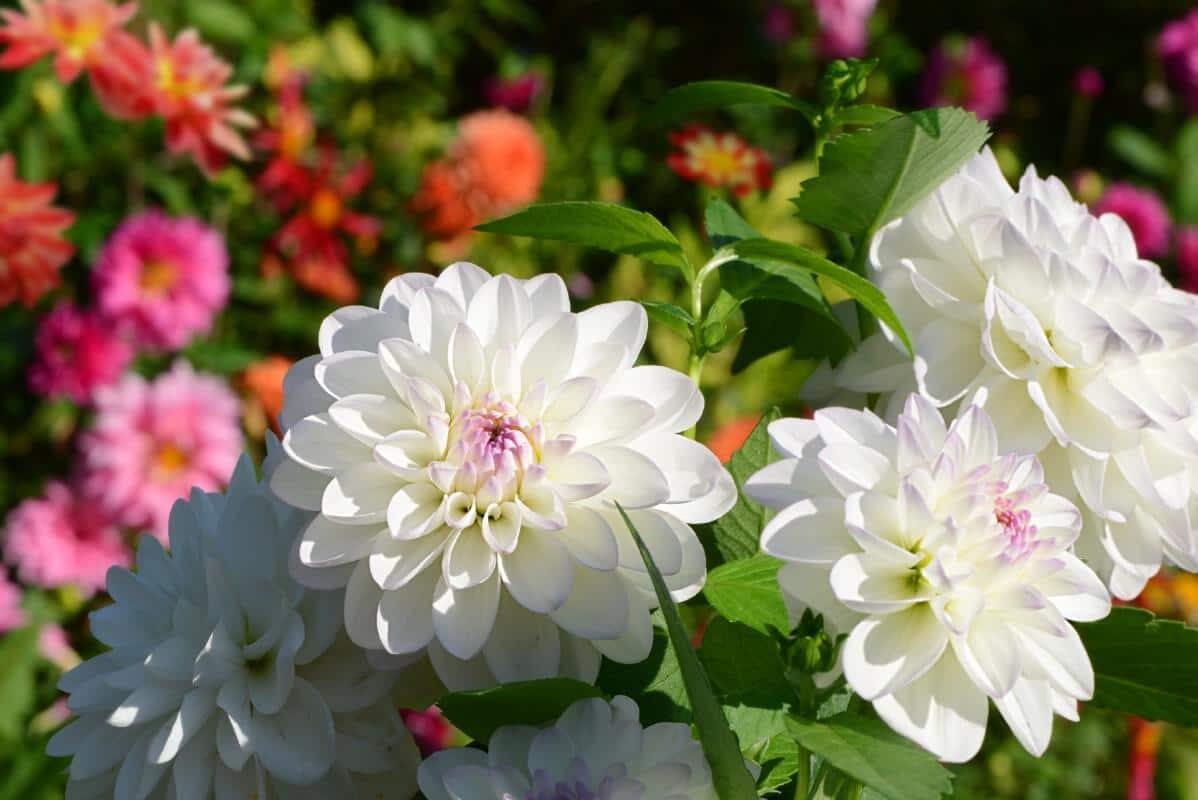
Zones: 2-11 (but if you are in zones 2-7, you should dig up your tubers to protect them from the cold every winter)
Blooming season: Summer and autumn
Expected height: Usually 3-4 feet tall
Soil: Well-drained soil
Sun: Full sun
Why Grow Dahlias?
Here are a few reasons to consider adding gorgeous dahlias to your garden:
- Endless variety. It would be virtually impossible for any one gardener to manage to grow every cultivar of dahlia in existence, as you will discover in the next section. The sheer variety of dahlias is staggering.
- They can live in most zones. With proper care during the winter, dahlias can come back year after year in most climate zones.
- Long-lasting blossoms. Dahlias can bloom for four months if you prune them properly. In some locations, you might even get them to last a few more weeks longer than that (but they will not survive a hard freeze, so you will need to take them inside before that happens).
- Deer usually don’t bother them. Chances are better than not that deer will leave your dahlias alone.
- You can grow them in pots. Dahlias are a flexible plants that can grow in your flower beds or in pots. So, regardless of what you find convenient or how much space you have, you can consider them for your garden.
- Butterflies and hummingbirds may like them. While not necessarily the biggest attractors of butterflies and hummingbirds, both sometimes take an interest in dahlias.
- Interesting care requirements. One more reason to consider growing dahlias is their intriguing and somewhat intensive winter care requirements. You have to dig the tubers up and bring them indoors each winter, and then replant them in the spring. While that is a lot of work, that isn’t necessarily a drawback if you find it interesting and enjoyable. It is actually pretty cool you can preserve a tuber all winter in a dormant state, and then watch it sprout and flower again year after year! Since they grow, you can also divide them and get more dahlia plants over time.
Recommended Dahlia Flower Varieties
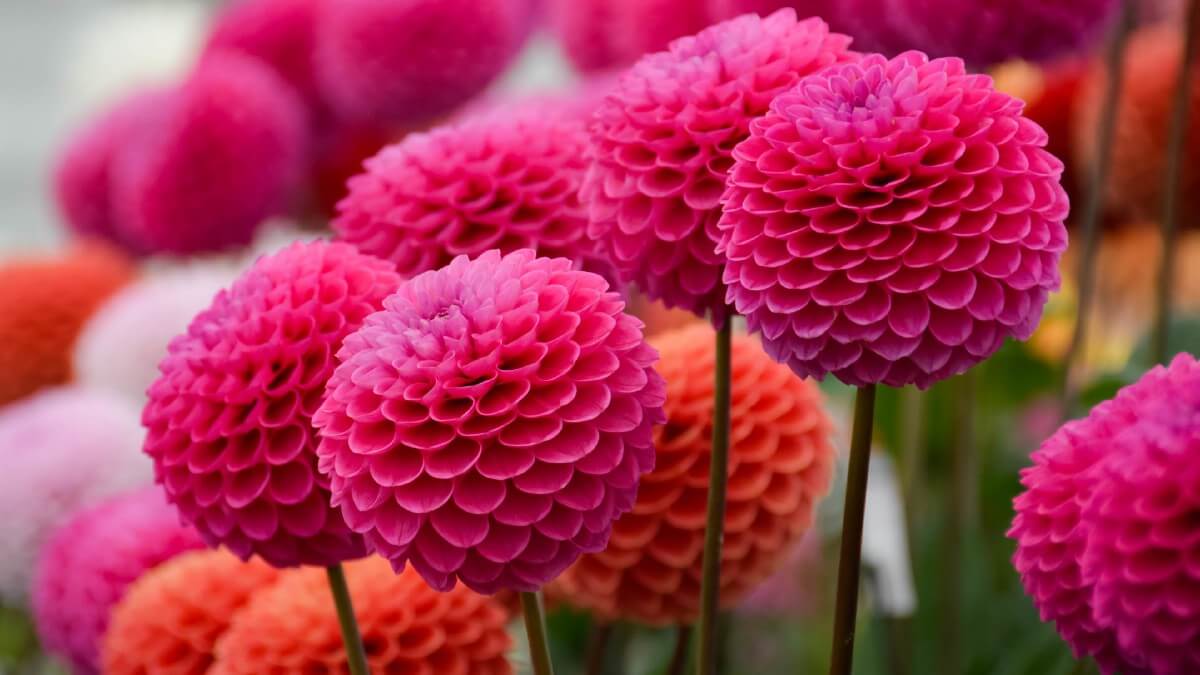
Before talking about specific cultivars of dahlias, it is useful to know that dahlia varieties are clustered into 14 different groups by the Royal Horticultural Society (RHS):
- Group 1 – Single-flowered dahlias (Sin)
- Group 2 – Anemone-flowered dahlias (Anem)
- Group 3 – Collerette dahlias (Col)
- Group 4 – Waterlily dahlias (WL)
- Group 5 – Decorative dahlias (D)
- Group 6 – Ball dahlias (Ba)
- Group 7 – Pompon dahlias (Pom)
- Group 8 – Cactus-flowered dahlias (C)
- Group 9 – Semi cactus dahlias (S–c)
- Group 10 – Miscellaneous dahlias (Misc)
- Group 11 – Fimbriated dahlias (Fim)
- Group 12 – Single Orchid (Star) dahlias (SinO)
- Group 13 – Double Orchid dahlias (DblO)
- Group 14 – Peony-flowered dahlias (P)
The New Zealand Society has a different way of grouping dahlia cultivars, specifically by their bloom diameters:
- Giant-flowered cultivars: over 250 mm.
- Large-flowered cultivars: 200–250 mm.
- Medium-flowered cultivars: 155–350 mm. Small-flowered cultivars: 115–155 mm.
- Miniature-flowered cultivars: 50–115 mm.
- Pompom-flowered cultivars: less than 50 mm.
In total, as of the time of this writing, there are over 57,000 cultivars of dahlias registered with the RHS. That is astonishing! Not only that, but the list just keeps growing—by about a hundred a year! So, here are just a few dahlia cultivars that might interest you:
- Bed Head: These tall dahlias feature reddish and orangey flowers with numerous narrow, twisting petals.
- Pooh: These dahlias are also tall, and produce many distinctive flowers. They feature large yellow centers surrounded by wide, neat, reddish petals with yellow tips. Surrounding the centers of the flowers are yellow sepals that look like petals themselves.
- Honka: Whereas a lot of dahlias have many petals, Honka dahlias have only a few. They are very thin with wide spaces between them so that the dahlias look like stars. Many people enjoy this variety of dahlias not just for their appearance, but also for the subtlety of their scent.
- Meagan Dean: This is a type of ball dahlia with numerous light purplish petals and long stems. The petals fade to near-white at the tips, giving these blooms an ethereal look.
- Black Satin: If you want to bring a darker color to your garden, consider this variety of dahlia with deep wine-colored blossoms. The name “black satin” references the beautiful sheen of the petals. They darken to near-black toward the centers.
- Clearview Daniel: For a dahlia with a truly unique look, consider the Clearview Daniel variety. The four-inch balls are yellow with tightly packed petals that are curled into funnel-like shapes.
- El Sol: Bring some sunny, eye-catching colors to your garden with this cultivar featuring 12-inch blossoms in bold yellows and oranges.
- Jitterbug: Looking for a dahlia cultivar that features smaller flowers? The blossoms on jitterbug dahlias are just a couple of inches in diameter. With their pink hues, they are a lovely addition to any garden.
- Poppers: These blossoms look like explosions of bright yellow petals. Adding to their visual interest, the petals feature red streaks and splotches. In fact, they look a little like French fries streaked with ketchup. Again, the list above is just a tiny sampling of the literal tens of thousands of dahlia cultivars that are out there! So explore the selections you can find online and at your local stores. You will never run out of exciting varieties to plant. Indeed, even if all you ever grew for the rest of your life were dahlias, you probably would never get bored!
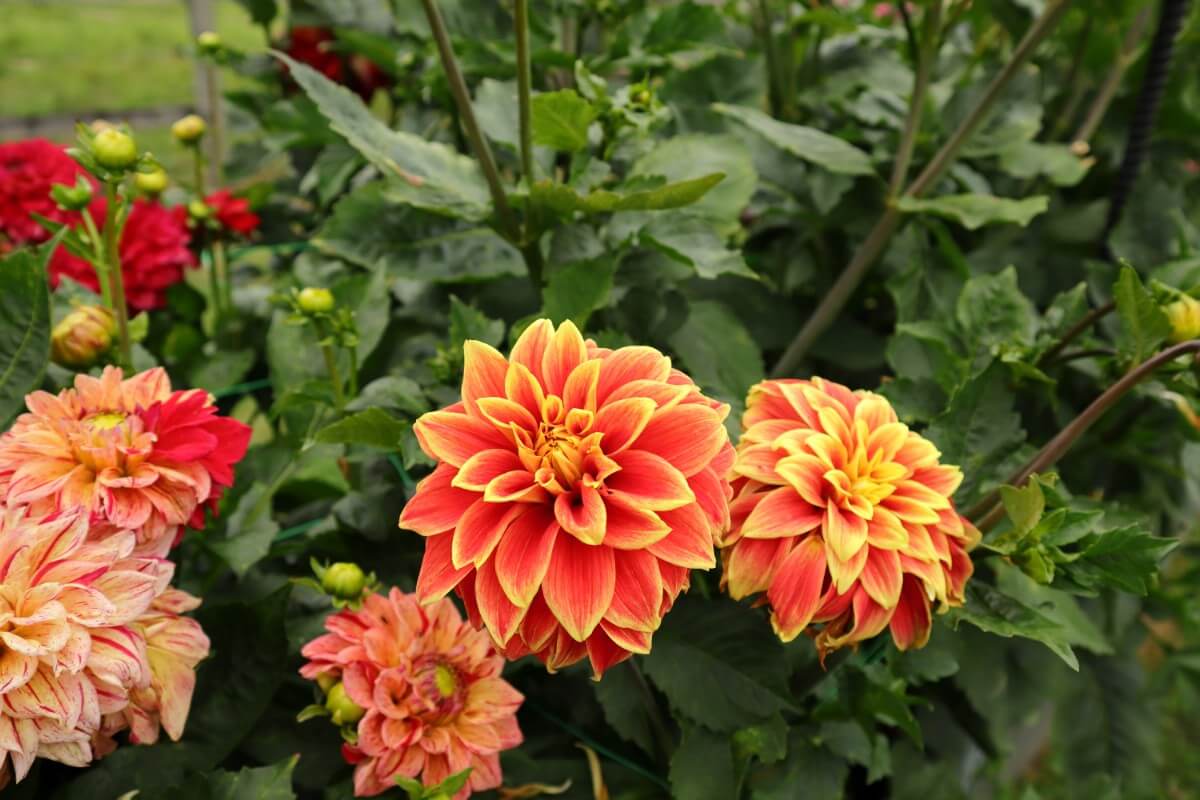
Where Do Dahlias Grow?
Dahlias are most prominently grown in the Americas (especially Central America). But they have been brought all around the world, and are also grown in Europe, Africa, Asia, and Australia.
When Do Dahlias Bloom?
You’ll need to wait around 8 weeks after you plant your dahlias for them to start blooming. Usually, the earliest dahlias in your garden will open their petals in mid-July.
How Long Do Dahlias Bloom?
The bloom time for dahlias is an impressive 120 days. That means that if your dahlias start blossoming in mid-July, you can expect to enjoy the beautiful blooms through mid-November. Long after many of your other flowers have died, dahlias will continue to bring color to your garden.
When to Plant Dahlias
Late spring is the time to plant dahlia tubers. The minimum soil temperature should be 60 degrees Fahrenheit. Moreover, you must be certain that the last frost has come and gone.
Do you grow tomatoes? If so, think about putting the dahlias in the ground just after you plant your tomatoes.
If you don’t want to wait that long, you do have the option of growing your tubers in containers indoors initially, and then transplanting them outdoors when the soil temperature is suitable.
If you decide to go that route, you can start about a month earlier than you would otherwise.
How to Plant Dahlias
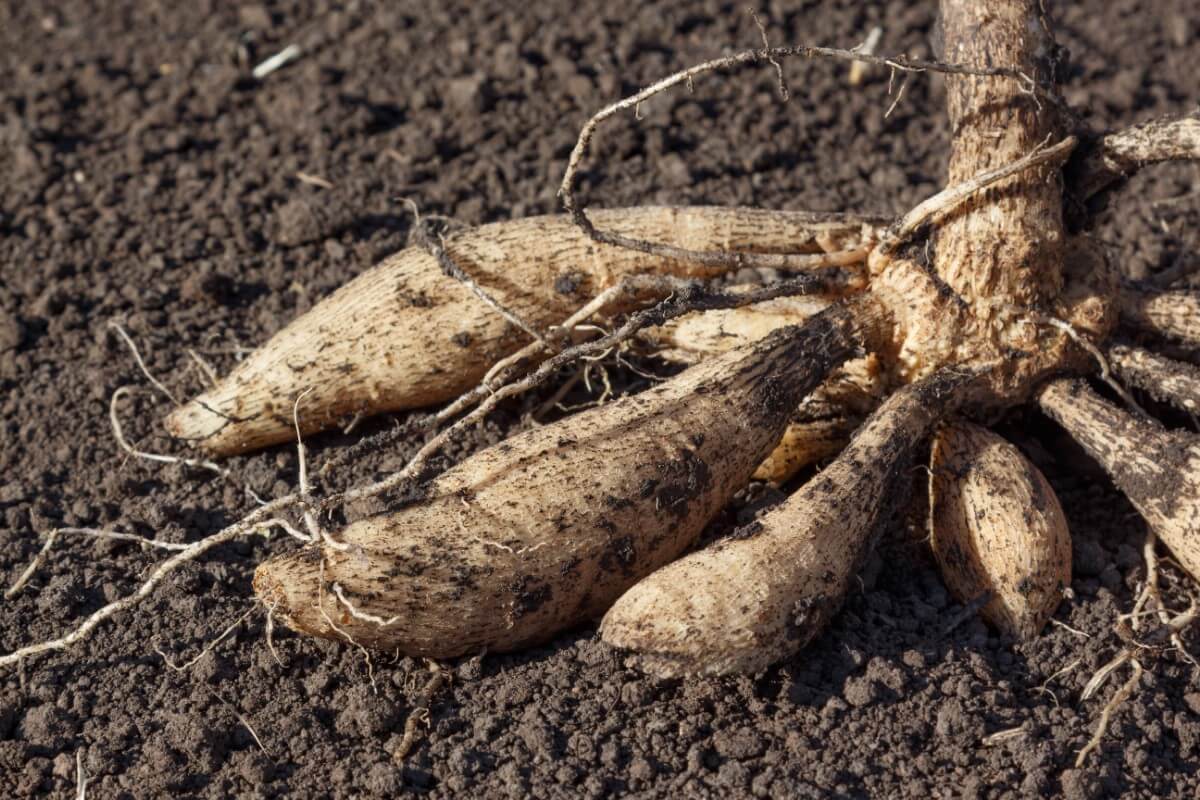
Direct Planting Outside
If you are planting your dahlias directly outside from tubers …
1. Begin by preparing the soil. Ideally, the pH should be 6.5-7.0. Don’t have adequately acidic soil? Add a bit of sulfur if you need to. Make sure the soil is also loose enough, and the right temperature (60 degrees Fahrenheit at a minimum; dahlias do not grow well in cold soil).
2. Next, dig a hole in your soil. How deep do you plant dahlias? You will need to dig down 6-8 inches. Make sure the hole is big enough to accommodate the root ball.
3. If your soil quality is not ideal, or if you want to provide some extra nutrition at this stage, you can add compost or sphagnum peat moss. But you should not use another fertilizer.
4. Put your dahlia tuber into the hole. For a tuber to be viable, there needs to be at least one eye. The sprout will emerge from it after you plant it. The neck must also be in good condition. When you place the tuber in the ground, the eye or eyes should face upward. The tail with the roots will be pointing downward.
5. Fill in the soil over the top of the tuber. Now it is time to cover up the tuber partially with soil. Anywhere from 1-4 inches should do the trick.
6. Consider putting a stake beside the tuber (more on that later).
7. Keep an eye on your tuber. When you see it sprout, you can fill in the rest of the hole. Resist the urge to water the tuber after you plant it. Only after it sprouts should you consider doing so.
How much space do your dahlias need?
That depends on the types you are planting. But if they are bedding varieties, 9-12 inches between each should be sufficient. Anywhere from 1-3 feet apart is ideal for other types of dahlias (the larger the plants, the more room they need). If you plant them relatively close together, they will form a hedge.
Starting Dahlias Indoors
If you are starting your dahlias indoors … If you want to start your dahlia tubers early, you can do so indoors about a month before you plan to transplant them outdoors.
1. Get a pot with drainage holes that measure around 8 inches across.
2. Choose an appropriate moist potting soil, and fill the container about halfway.
3. Put the tuber in the pot.
4. Add another 1-2 inches of potting soil.
5. Water the plant. You should have some running through the drainage holes by the time you stop.
6. Put the dahlia in a window where it can get lots of sunlight. If it is cold in your house, use a seed-warming mat so that the soil will be at the right temperature.
7. Mind the soil does not get too dry. When the soil outside gets to be 60 degrees Fahrenheit and the last frost has passed, you can transfer the plant outdoors.
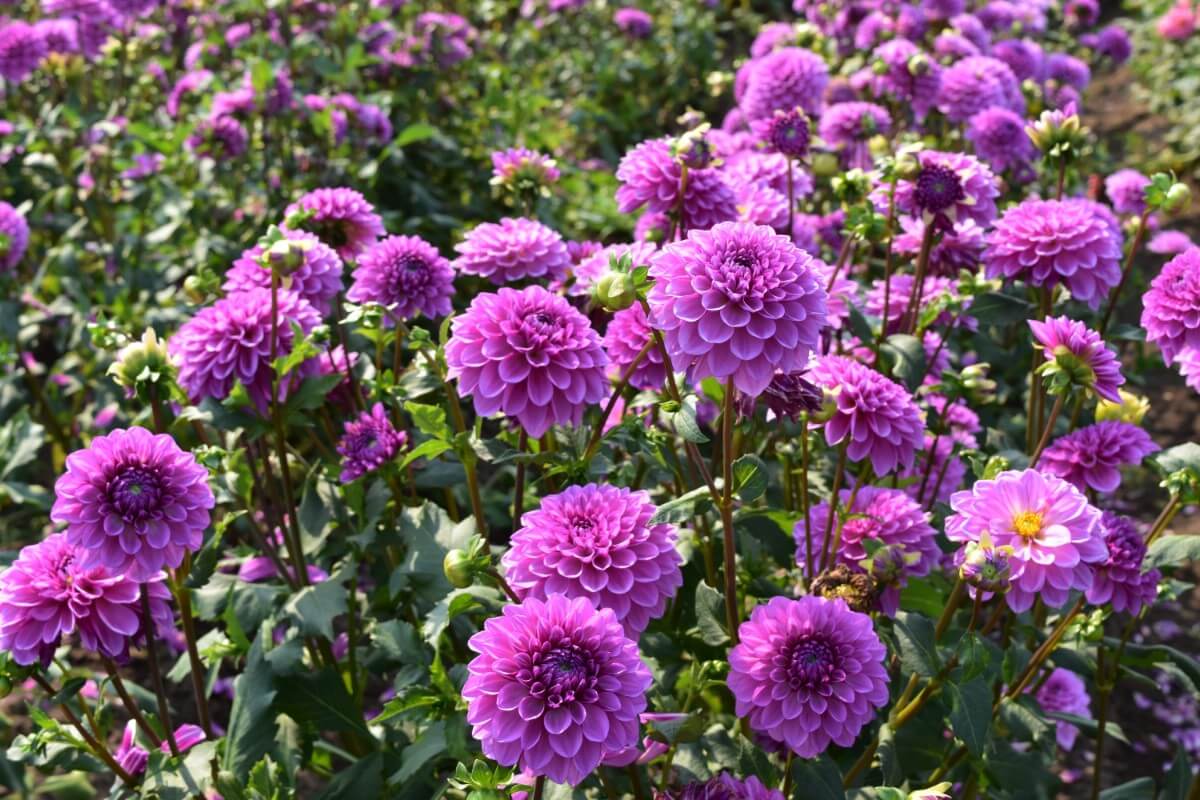
Starting Dahlias from Seed Indoors
If you are growing dahlias from seeds …
1. Put seedling mix in a seed tray or pot.
2. Get the mixture damp.
3. Make holes for the seeds. They should be separated by about an inch of space between each, and they should be about half an inch deep.
4. Insert a seed into each hole.
5. Add more of your seedling mix so that the seeds are fully covered.
6. Put the seed tray or pot next to a window where there is a lot of sunlight.
7. Water the seeds every day. Wait two weeks for the seeds to germinate.
8. Did you start with a tray? After the seedlings are 2-3 inches tall, transfer them to pots.
9. Bring the seeds in their pots outside for a brief period of time, and then back indoors. Then bring them out again for longer, and then back inside (they should be inside at night when it is colder). Keep doing this over the course of a week. This is how you will acclimate them to life outdoors.
10. You should now be ready to transplant your dahlias into your garden beds (or keep them outside in pots if you prefer).
How to Transplant Dahlias
Regardless of whether you went with a tuber or a seed, you should transplant your dahlia plants outdoors before they are a foot tall.
As discussed above, it is necessary to bring the plants indoors and outdoors over a week to harden them.
After that, you can keep them outdoors day and night without breaks. But you should keep them in their pots for the first few days.
Protect them from wind and rain during this transitional phase. After they are fully acclimated, you can go ahead and finally put them in the ground.
Ideal Growing Conditions for Dahlias
We have already briefly talked about the soil conditions that dahlias prefer, but let’s talk a little bit more about both soil and sun.
How Much Sun Do Dahlias Need?
Dahlias adore sunlight. So, if possible, give them 6-8 hours of full sunlight every day. The more sun they get, the more blossoms you will be able to enjoy.
Also, keep in mind when you are choosing a location in your garden that dahlia stems are not too sturdy. Strong gusts of wind can break them. So, if you have a spot that gets lots of sun but is sheltered from the wind, that is ideal.
What Type of Soil is Right for Dahlias?
As we already mentioned, a pH of 6.5-7.0 is appropriate for dahlias. Dahlias do not do well in poor soil, so choose rich soil.
Because the soil needs to be able to drain, it is important to take the time to loosen it if necessary.
You should not try to plant dahlias in clay. It is way too dense, and if it gets wet, it becomes muddy.
If you are absolutely stuck with clay but are determined to grow dahlias, try mixing in sand, manure, or peat moss. You might have some luck.
How to Care for Dahlias
Now that we have gone over ideal growing conditions for dahlia blooms as well as when and how to plant them, let’s go over basic care and maintenance recommendations for these flowers.
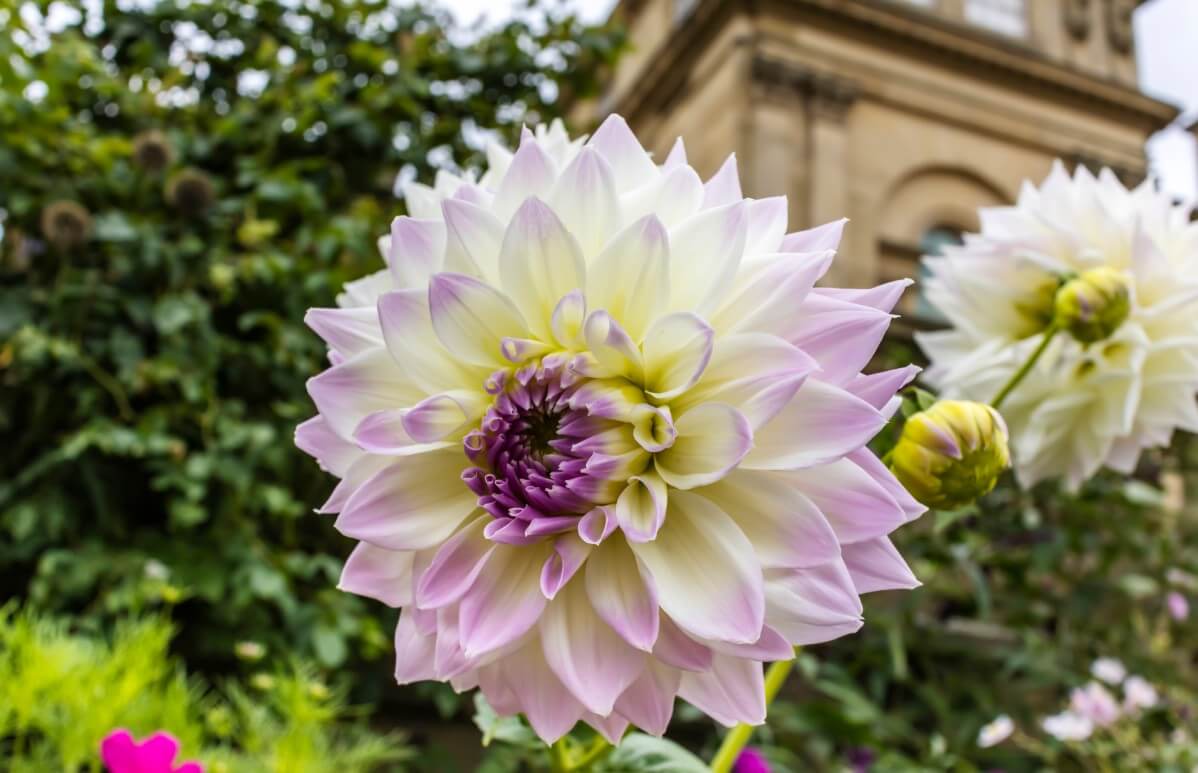
How Much Water Do Dahlias Need?
Dahlias do require regular watering and moist soil. But you do not want the soil to get soggy, so make sure it is draining adequately, and that you are not watering too often or too much.
If you over-water, you can expect rot. You could lose the tubers.
How to Fertilize Dahlias
Fertilizing dahlias isn’t really optional. These plants require serious nutrition. Indeed, they should be planted in fertile soil. But even in rich, well-drained soil conditions, dahlias need some extra nourishment.
You should choose a fertilizer formula that is relatively low in nitrogen. Even though fertilizing your dahlias is important, you do not need to do it all that often.
If you notice that your dahlias are starting to droop and the leaves are turning yellow, consider scaling back on the fertilizer. You might be overdoing it.
The best times to fertilize your dahlias are:
- A month after you plant them.
- A month after that.
How much fertilizer is the right amount? Roughly half a cup should be adequate.
How to Mulch Dahlias
Do you live in a dry, warm climate where moisture evaporates easily? If so, you may want to consider mulching around your dahlias. Doing so will help keep moisture locked into the soil.
Alas, mulching can also lead to cooler soil, and dahlias thrive in warmer conditions. So, unless mulching is necessary to prevent your soil from drying out, you might want to avoid it.
Plus, there is a chance that slugs will feel at home in the mulch, and that is not something you want.
How to Stake Dahlias
Dahlias can get to be quite large and heavy, depending on the cultivars you have chosen. If they become too heavy, they can fall over if you do not support them.
So, you may need to stake some of your dahlias. Either metal or wooden stakes can serve your purpose. You will need some string or twine to attach your plants to the stakes.
Whether you go with a wood or metal stake, it is your choice when to take care of this chore. You can wait until you are sure your dahlias need staking, or you can stake at the same time you put the tubers in the ground at the start of the growing season.
The latter route has a couple of benefits. First of all, staking will be out of the way, so you can focus on other things. Secondly, the fragile dahlia stems will have support as they are growing, which may be helpful, depending on your climate.
How to Prune Dahlias
Now, let’s talk about pruning your dahlias. You can do this by deadheading, pinching, and disbudding. We explore each of these in detail below.
How to Pinch Dahlias
“Pinching” dahlias is something you have to do in spring. It can be a bit of a hassle, but thankfully, you only have to do it one time per season.
The University of California Master Gardeners of Inyo & Mono Counties writes, “This is the hardest part. As the stem emerges from the ground, the main stalk develops two branches on either side. After three of these branching pairs form on the stalk you have to pinch out the center. This encourages lower branching of the plant and will give you a stronger plant and more blooms on top!”
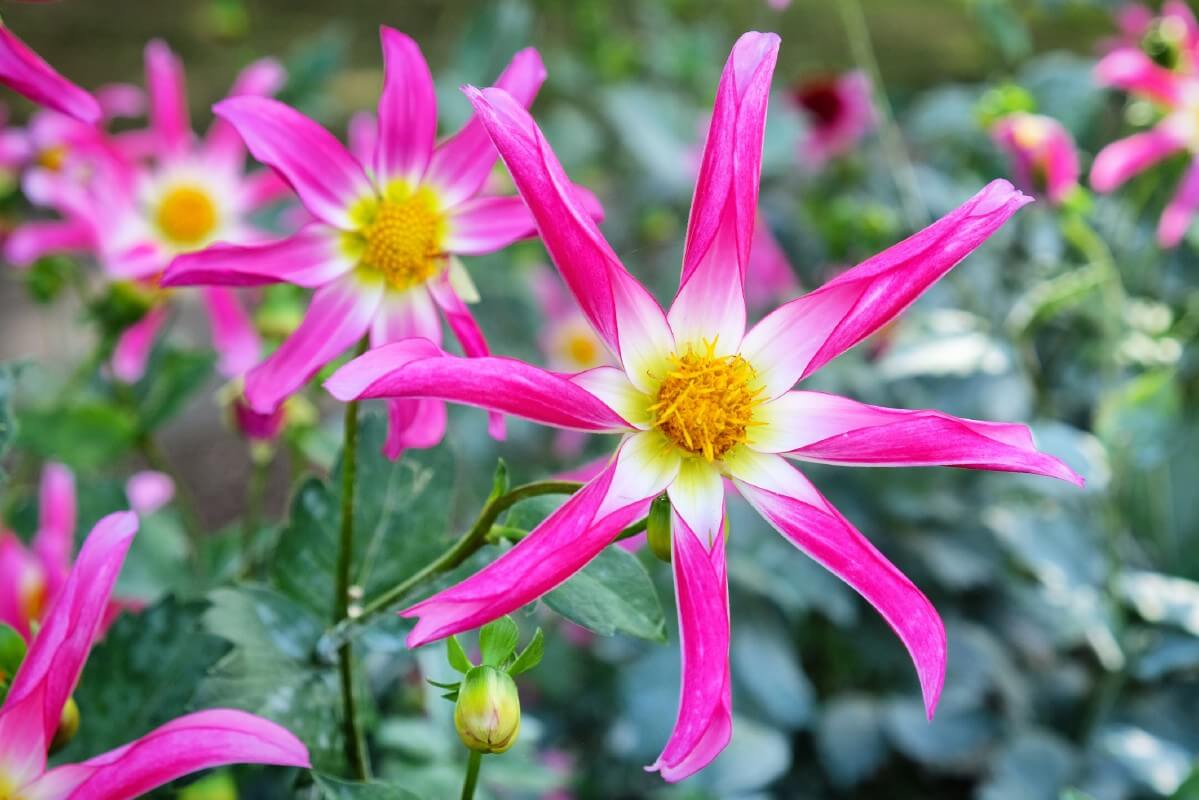
How to Disbud Dahlias
If you find a whole bunch of buds on one stem, you may be excited—your dahlia plant is going to produce a ton of big, beautiful flowers, right?
But actually, there is a chance all of those flowers will be smaller and less spectacular than you expect.
The University of Georgia Extension explains, “Dahlias produce more flower buds than the plant can supply with food. Disbudding is necessary to channel sufficient food to a select number of flowers.”
So, you will want to “disbud” your dahlia but getting rid of the excess buds.
UGA continues, “When the flower buds of the tip cluster are about the size of peas, remove all but one. At the same time, pinch out the small, tender growth buds in the leaf axils of the top set of leaves on the stem. You might also need to do the same for the buds coming from the base of the next set of leaves if the variety produces short stems.”
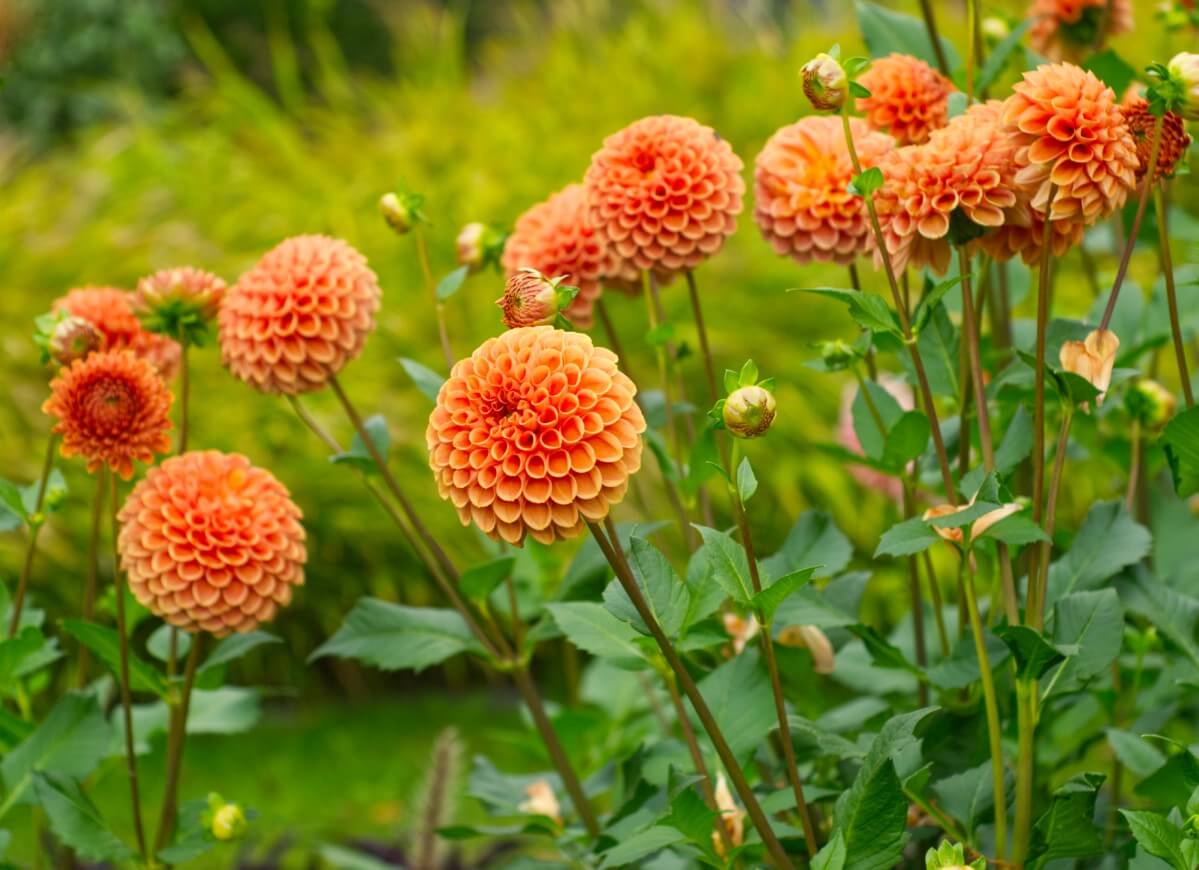
How to Deadhead Dahlias
It is worth spending a moment talking about deadheading dahlias. Taking the time to deadhead them is worth it, as it results in a longer blooming season.
If you are used to deadheading other flowers like black-eyed Susans, you might feel like you already know how to deadhead dahlias. But actually, dahlias are a little harder to deadhead than some other plants.
The problem is that it is difficult to visually distinguish the difference between a dahlia flower after it loses its petals and a bud of a fresh flower.
But it is only hard if you do not know what to look for and you are not careful.
All you need to pay attention to is the shape. Is it a cone, or is it round?
If you see a round shape, do not remove it—it is a bud, and should soon open up into a beautiful flower. But if you see a conical shape, you can go ahead and take that off. Be careful not to disturb any new buds that are near it.
Are Dahlias Vulnerable to Diseases or Pests?
As already discussed, rot can set in with dahlia tubers if you over-water or if you plant them in soggy soil or in standing water. But what other issues can potentially affect your beautiful blooms?
Not surprisingly, powdery mildew can be an issue with dahlias. This is another result of exposure to too much moisture. Space out your plants adequately, don’t let the soil get soggy, and try not to get the leaves too wet.
Some pests that can cause problems with dahlias include Japanese beetles, mites, earwigs, aphids, slugs, and caterpillars. If you spot caterpillars or slugs congregating around your dahlias, you may want to take them somewhere else.
What to Know About Dahlia Tubers
Let’s talk a little bit specifically about dahlia tubers. Because tubers are susceptible to cold, dahlias require a little more care than some other flowers you may grow.
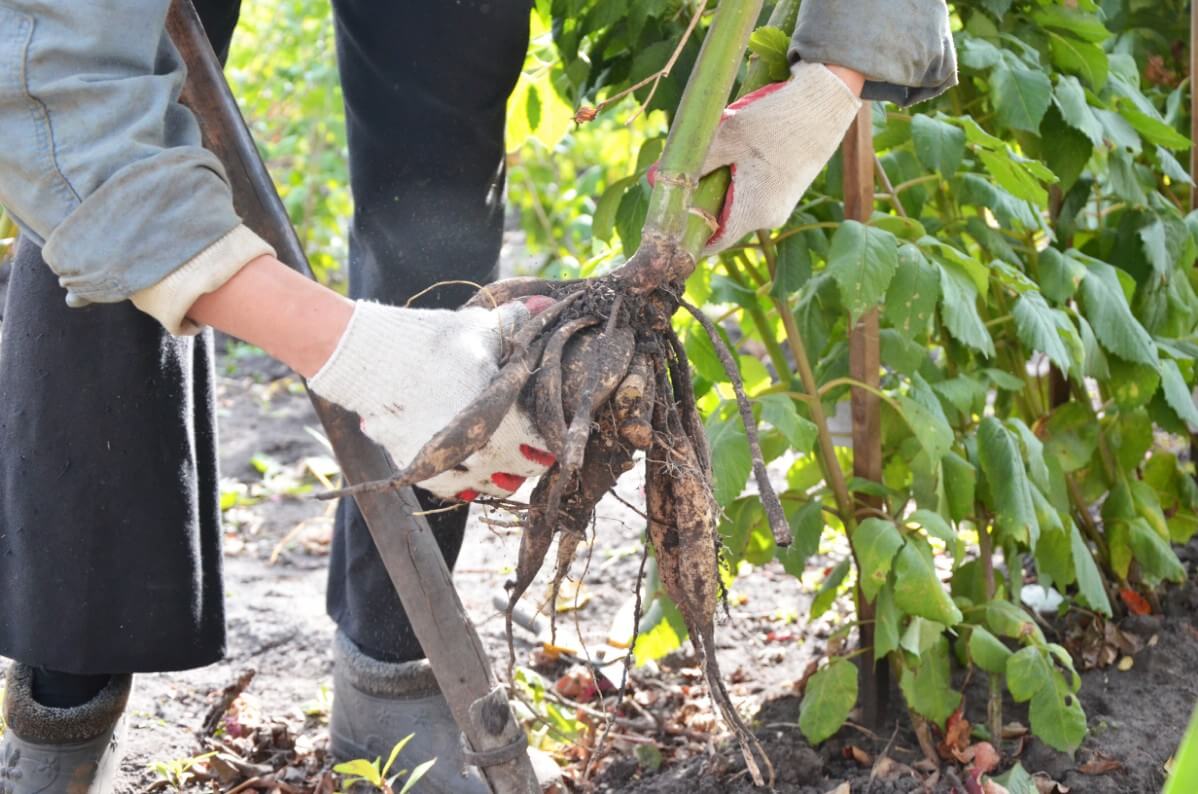
When and Why to Dig Up Dahlia Tubers
If you live in zone 8 or above, you may not need to worry about leaving your dahlia tubers in the ground over winter, especially if you do not get a lot of precipitation.
But if you live in any zone up to 7 and/or you get any frost at all, you should not leave tubers over winter in the ground.
You also should not do so if you get excess precipitation during the winter.
If you leave them out there, they will die, and it will happen fast.
So, make sure you get them out of the ground prior to the first hard freeze.
How to Dig Up and Clean Dahlia Tubers to Store Them
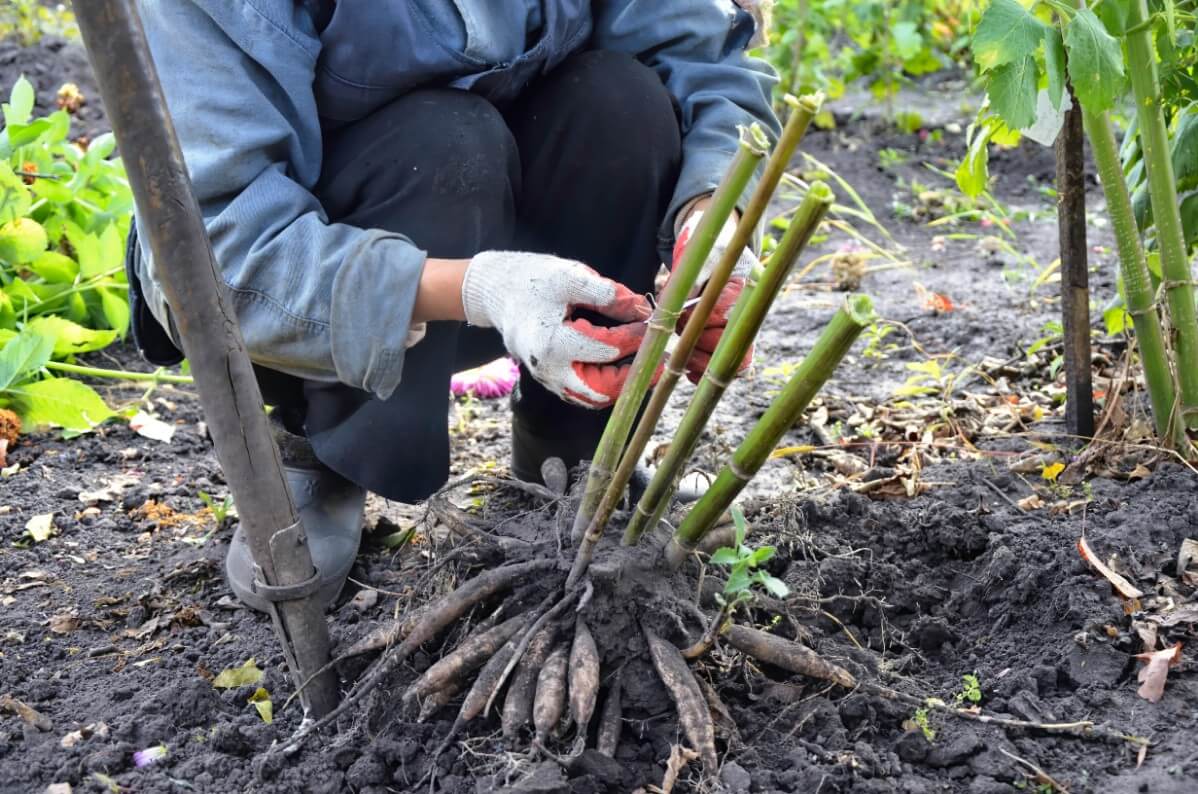
You will find that it is not too difficult to dig your tubers out of the ground. Make sure you do so by hand, as you could damage them otherwise. You can use a tined fork or shovel to assist, but be very cautious.
After you have removed them from the soil, you can cut off their stems, leaving just several inches.
Rinse off the tubers with a garden hose.
Next, consider dividing them now rather than waiting for spring. The American Dahlia Society says, “It is much easier to divide roots in the fall (some varieties become so hard over the winter that one would need a power saw to separate them in the spring), but it is correspondingly harder to find the eyes before they start to sprout. Many growers divide their roots in the fall.”
You will need to keep the tubers moist and cool through the winter. The National Garden Bureau says, “You can store the tubers in a variety of containers – milk crates, plastic bins, paper bags, and cardboard boxes all do the trick. Just make sure there is space left between each tuber and there is some air circulation. Place the tubers in a cool, dark space that won’t freeze. For many, this could be an unheated basement, attic, closet or utility room.”
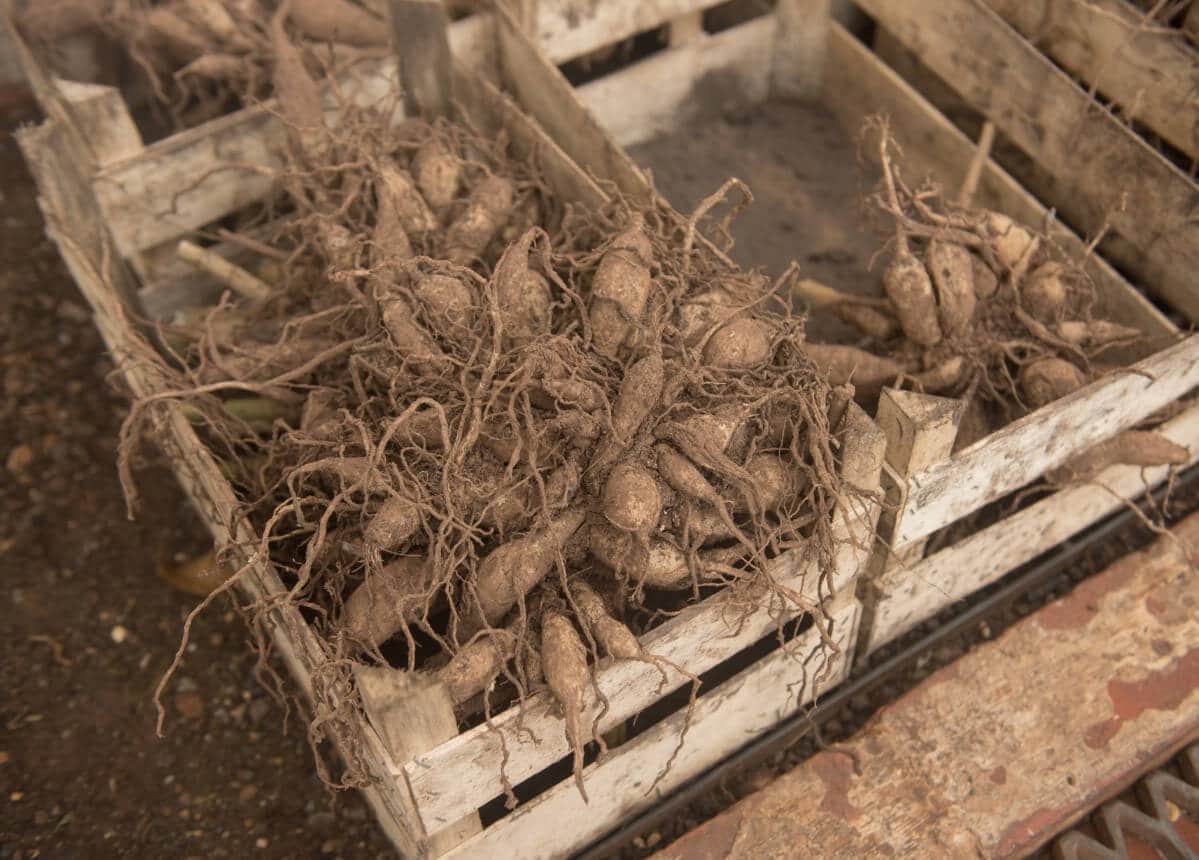
The American Dahlia Society offers detailed ideas and suggestions at the linked page. Can you still grow dahlia tubers that have dried out? Often, the answer is a surprising “yes.” Often, the interior of the tuber is still moist, even if the outside is not, so if you plant it, it might grow.
Recommended Companion Plants for Dahlias
What plants go well with dahlias? Let’s take a look at some companion planting ideas.
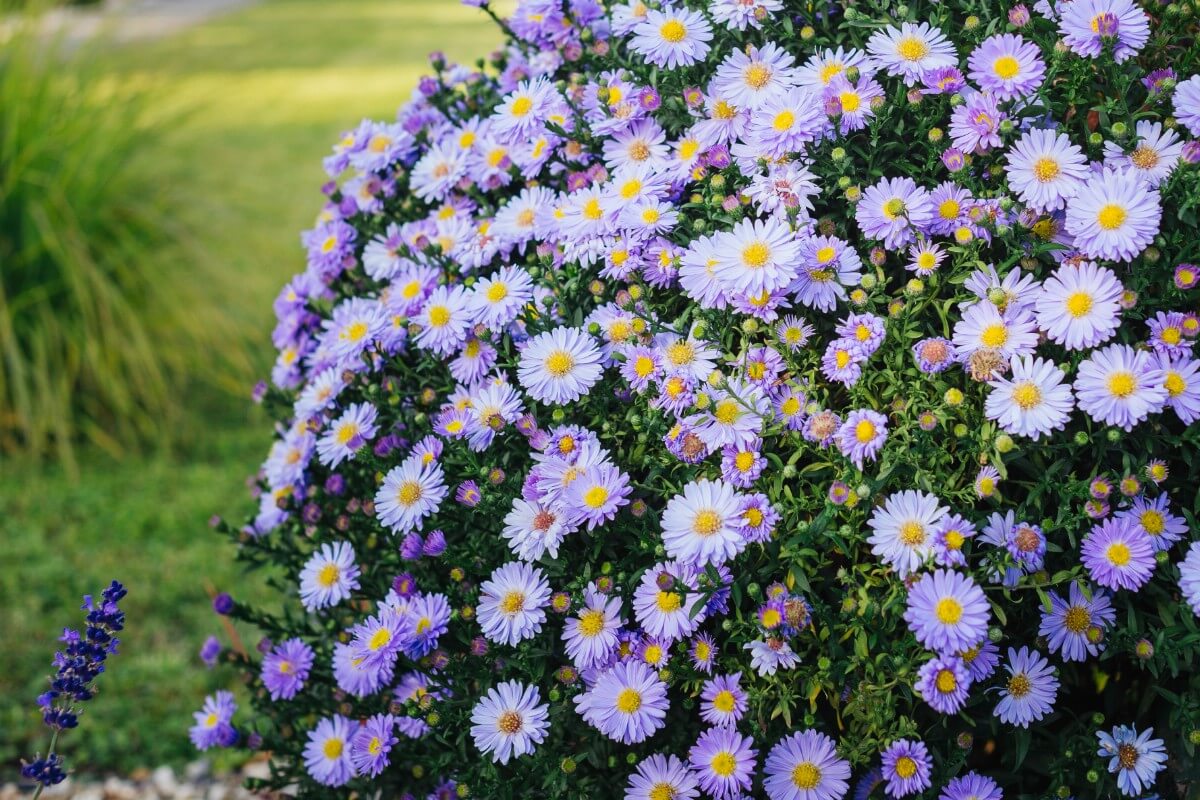
Wormwood. This plant with its silvery leaves is one that slugs don’t like. So, it can help to keep them away from your dahlias.
Italian asters. The bright purple petals and yellow centers of these flowers will look great next to colorful dahlias. These asters do a good job resisting mildew.
Anise, coriander, or onions. If you are specifically trying to keep aphids away from your dahlias, any of these three plants might be good to place nearby. The American Daylily Society says, “If control is desired, insecticidal soap can be effective if the aphids are located where they can be directly hit by the spray. Numerous other low or non-toxic remedies are discussed in various references including repellent companion plants such as the allium (onion) family, coriander and anise.”
New England asters. These plants are deer-resistant. So, if by any chance deer are bothering your dahlias, these asters might be useful for surrounding them.
Salvia. Love the butterflies that are attracted to your dahlias? Draw even more by planting some flowering sage next to them.
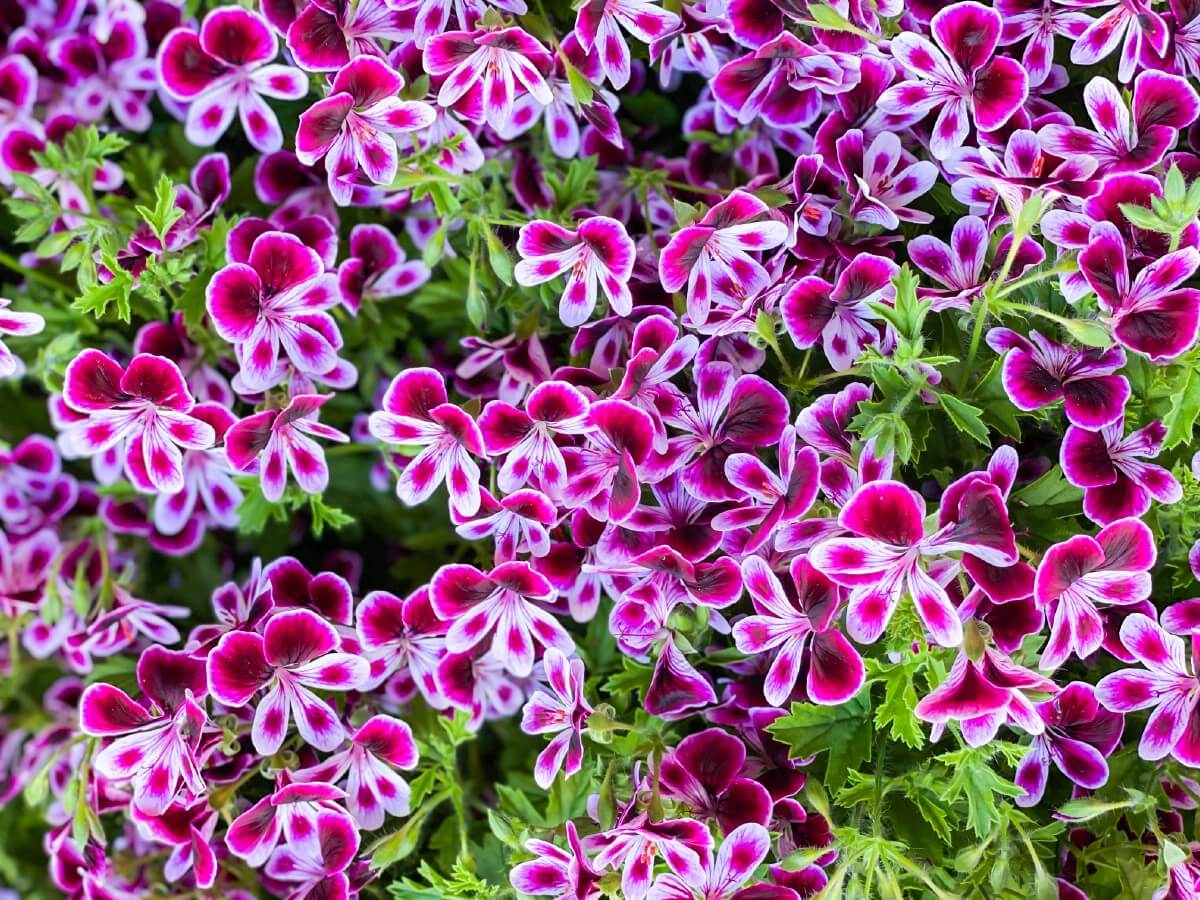
Geraniums. You can plant these near your dahlias, but not too near if you are having issues with Japanese beetles. The beetles may notice the geraniums and lose interest in the dahlias. Of course, then you will have to deal with them on the geraniums. Bee balm. To attract bees to your dahlias, plant some bee balm beside them. Those are just a few companion plant ideas for dahlias. There are many more possibilities you can consider!
Where to Buy Dahlias
Ready to get started growing your own beautiful dahlias? To bring these breathtaking blooms to your own garden, you need to purchase dahlia tubers or dahlia seeds.
If you check your local garden center, you should find at least a few options in the dahlia department. You also can check in with local dahlia clubs to see if they will be holding any sales. It is also possible to buy dahlia tubers or seeds online.
In fact, this will give you access to the widest variety. With tens of thousands of gorgeous cultivars awaiting you, you can find the perfect dahlia to suit any spot in your garden. To get dahlia tubers and seeds now, click the link below.
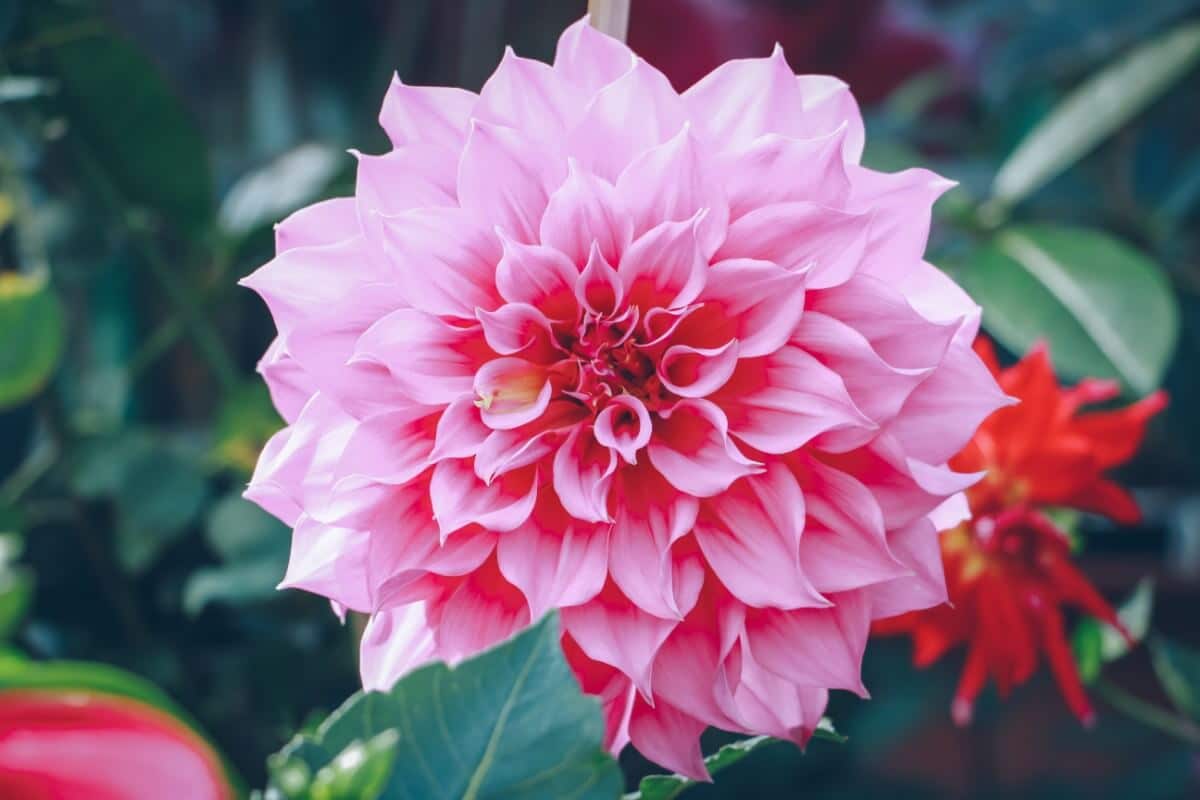
Frequently Asked Questions About Growing Dahlias
Around 3-4 feet of height is a typical range for many dahlias. But if you plant dwarf dahlias, they may get no taller than 12-18 inches. If you grow a taller variety, you might get dahlias up to 6 feet in height. Do not forget to stake tall dahlias.
Slugs, snails, caterpillars, aphids, earwigs, and beetles may all eat dahlias. Slugs and caterpillars are probably the most common culprits.
Dahlias are perennials, but they cannot remain outdoors in most climate zones during the winter, so you have to dig them up, store them, and re-plant them later. Some people don’t like all this work and grow them as annuals instead.
Hypothetically, yes, you might get away with this. You’ll want to cut away the stalks and leaves, and make sure that the pot is somewhere cool and dark. Make sure it doesn’t dry out, but doesn’t get soggy either.
They require some maintenance, especially over the winter, but no, dahlias are not particularly difficult to grow.
If you want your dahlias to bloom for four months, you will need to deadhead them.
Yes, they do. A good starting point is dwarf dahlias or low-growing varieties, but those are not your only options. With some practice and the right maintenance, you can grow taller dahlias in pots as well.
You will want to go with heavy-duty containers to grow dahlias in pots. Plastic is just fine, and may be preferable to ceramic since you can more easily drill holes through it (you will want holes for staking).
Be sure and clean the pots you will use thoroughly, and choose a rich, loose potting soil or mix.
You can read detailed recommendations for growing dahlias in pots at The American Dahlia Society.
Not sure you should shell out $10 for a dahlia tuber? A lot of beginning dahlia growers balk at how pricey some tubers are.
But the reason dahlia tubers cost so much is because growers have to dig them up to protect them in the winter and divide the clumps by hand.
But here’s the thing—you can divide dahlia tubers yourself, so over time, you will end up with more dahlias. When you look at it that way, the price for one tuber may not seem as exorbitant.
That depends on whom you ask. Deer do sometimes like to chow down on dahlias, but not all that often. There are a lot of other plants they would far prefer to eat. So, they are a pretty good option if you have difficulties with deer in your area.
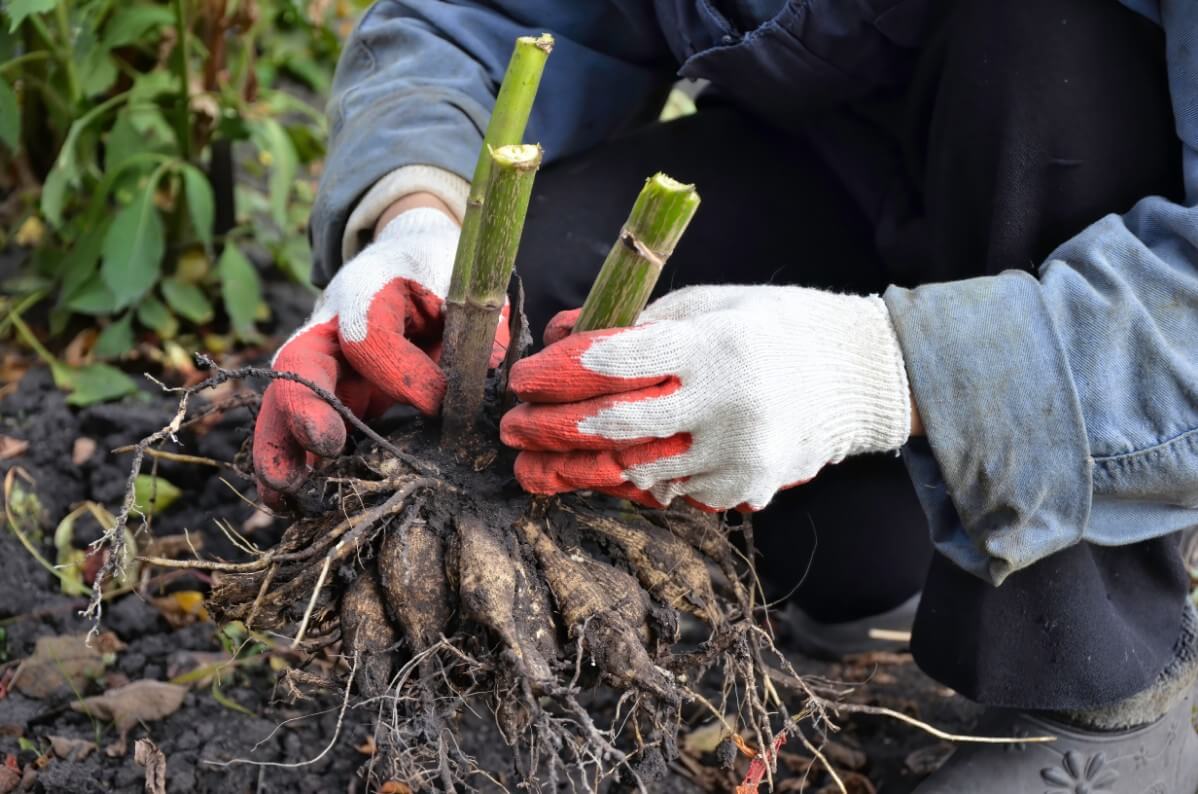


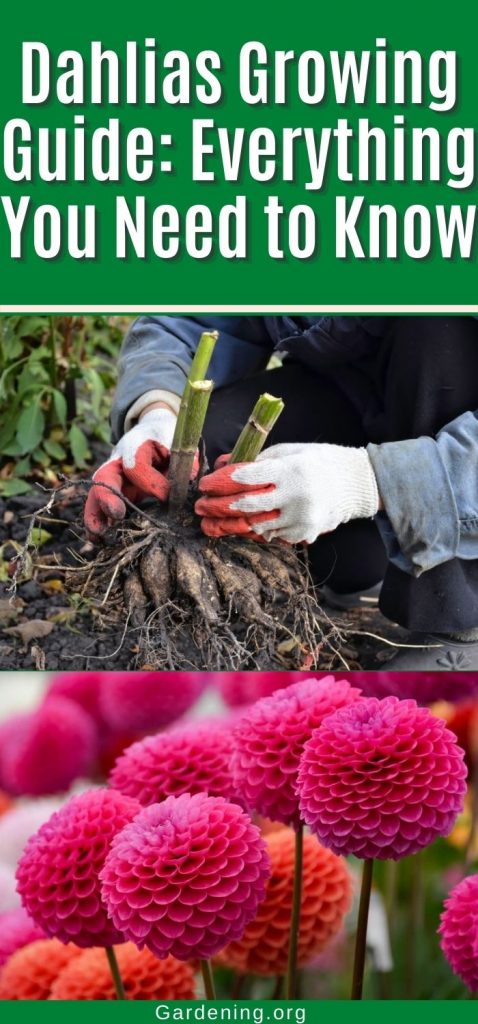
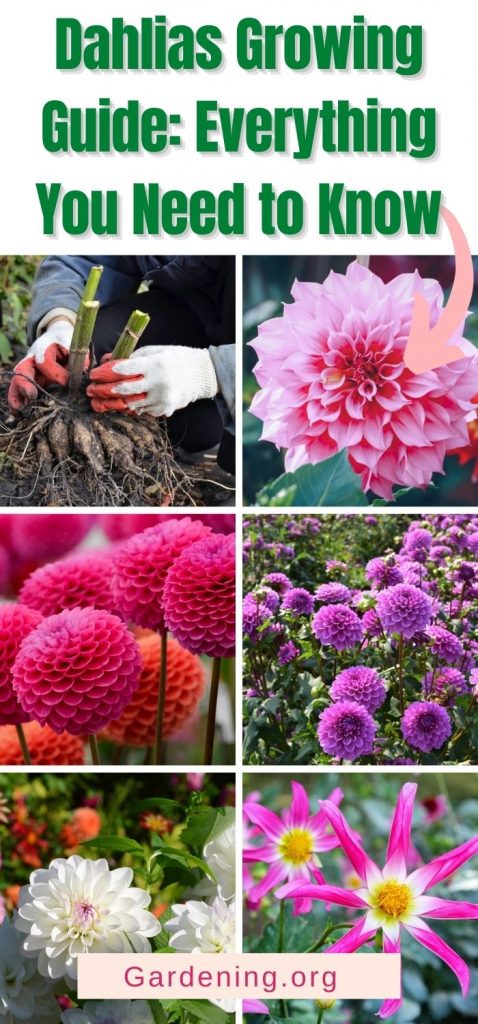
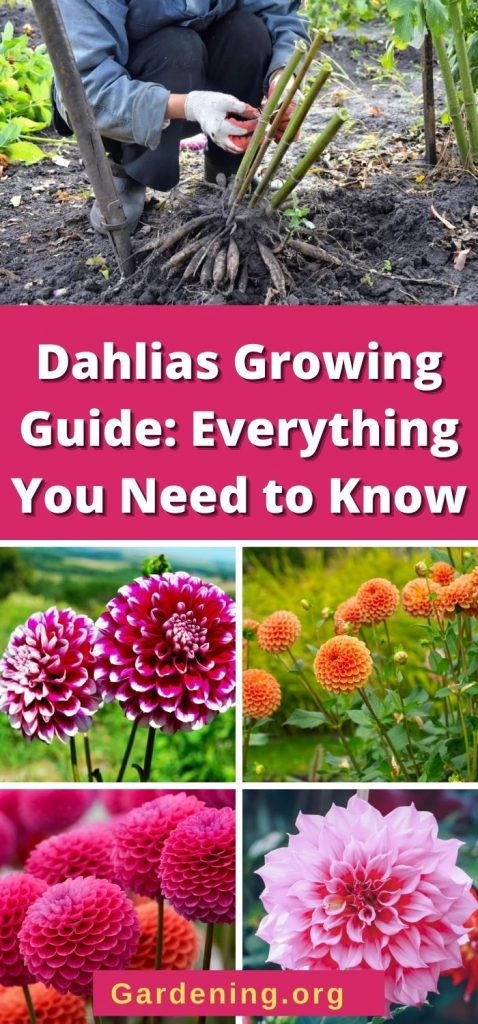

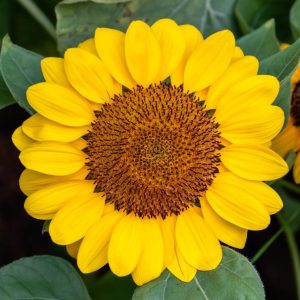
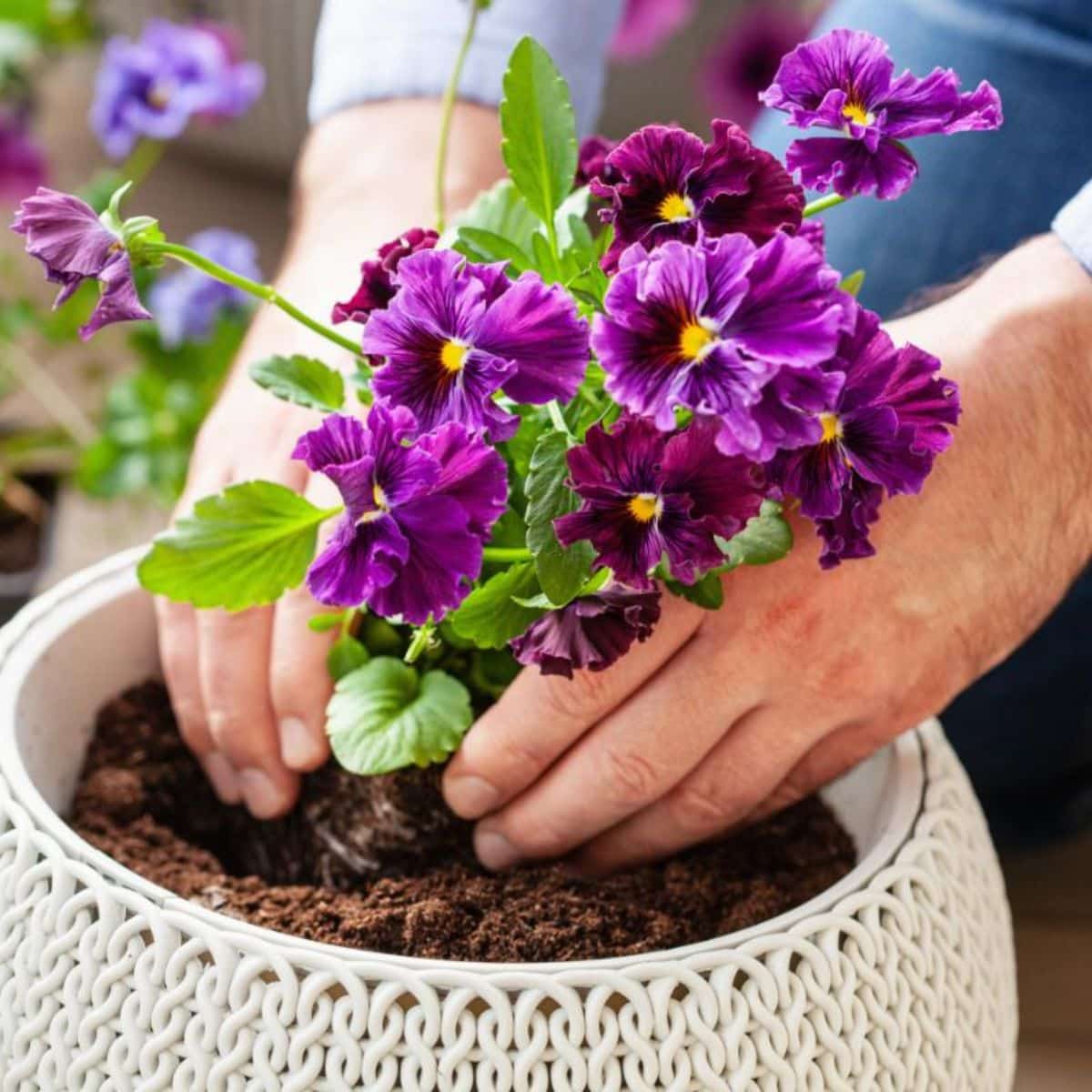
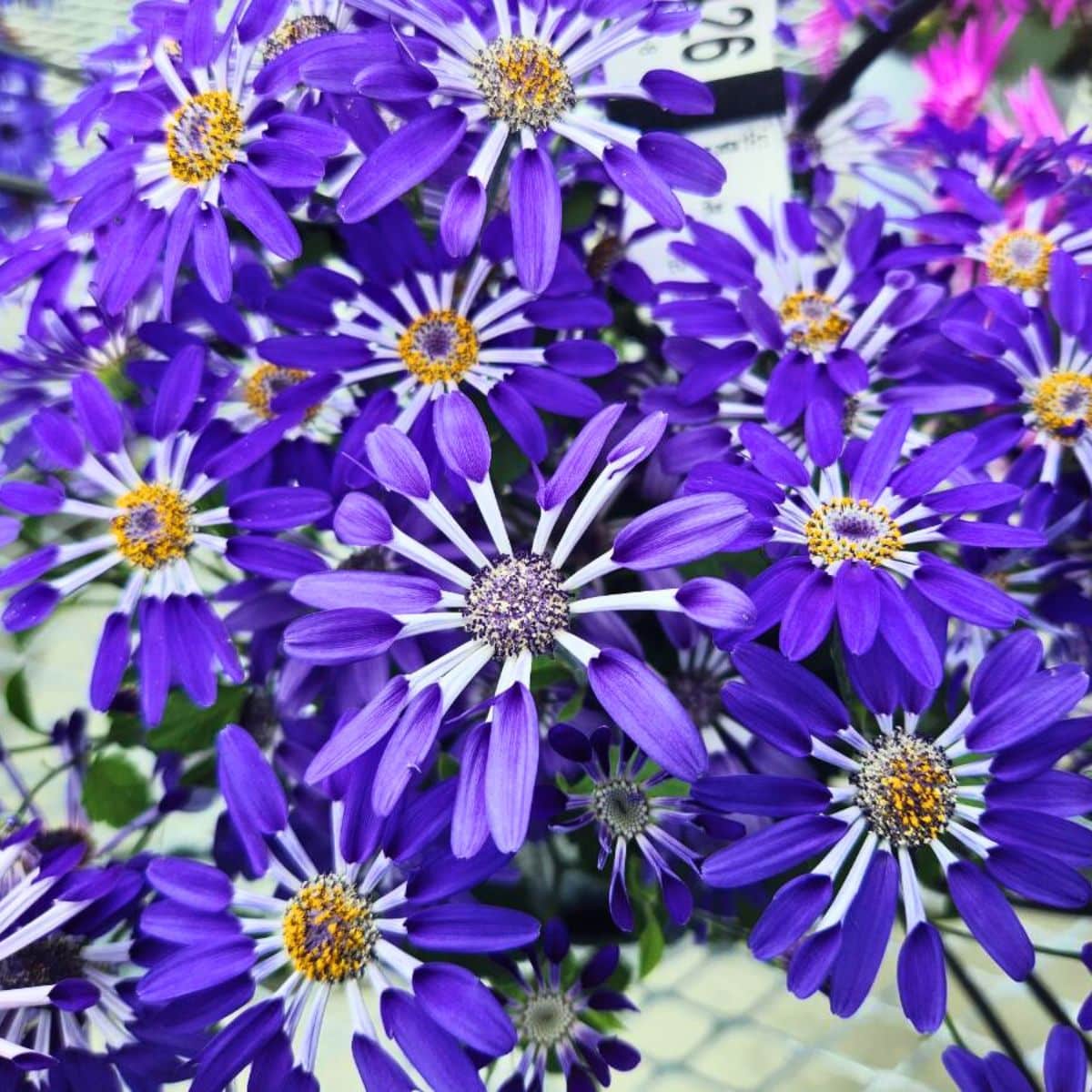
John Hood
Very interesting publication many thanks
Ward OCONNOR
My dahlia plant has grown to 3ft very full looks extremely healthy but not a hint of a bud anywhere. All my other plants have been in full bloom for about 3 weeks. I’m in Oak Forest, Illinois
Mary Ward
Don't give up. Dahlias can be slow starters.
Buz
Thank you a very informative write up. Picked up quite a few answers.. Thank again
Sue Novosel
I was not able to plant my dahlias until the beginning of September this season. I live in Southwestern PA. There are a number of plants that are not going to bloom this season. Will they produce flowers next year if they are overwintered properly?
Mary Ward
Hi Sue. I see no reason to think they would not. Sounds like you just ran out of runway. I'm not sure what zone you are in and if Dahlias are hardy there. Here in zone 6a/5b, we have to dig and store the tubers for the winter. I suspect you are on the line there and might need to as well. Even though you didn't get flowers, the tubers will have grown and multiplied and been fed--so you were right to get them in the ground; they likely would have dried up and died otherwise. So yes, take whatever winter precautions are advised for your area, and plant them again in the spring as soon after the danger of frost has passed as possible. Good luck!